This page contains the AQA GCSE Chemistry C1 Atomic Structure Questions and kerboodle answers for revision and understanding Atomic structure.This page also contains the link to the notes and video for the revision of this topic.
C1.1 Atoms AQA GCSE Chemistry C1 Atomic Structure Kerboodle: Page No. 05
1a As Elements on the left side of the periodic table are metals and on the right side are non-metals, we can classify them as:-
Metals: Barium Ba, Vanadium V, mercury, Hg, potassium, K, uranium, U
Non-Metals: Phosphorus, krypton, Kr.
b Hydrogen should be classified as a metal. Although hydrogen has 1s1 of electronic configuration, it does not show any of the properties that resemble alkaline metals. Therefore, hydrogen is not a metal. However, it shows many properties that resemble a non metal. Hydrogen forms covalent compounds, does not easily form cations and exists as a diatomic molecule. Therefore, it is considered non-metallic.
2 When we mix two elements together we can separate them quite easily by physical means but when two elements are chemically combined in a compound they are difficult to separate as compound is composed of two different atoms connected by strong chemical bonds that keep the atoms very tight. Therefore, they are very difficult to separate from the two elements mixed together. On the other hand mixtures are held together by physical means and no chemical bond is involved. Mixtures can be easily separated by physical means. Chemical bonds are difficult to separate and needs large amounts of energy to overcome the force of attraction in a chemical bond.
Diagram to explain the difference between an element and a compound
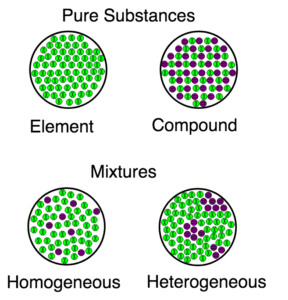
Source: Wikimedia Commons
An element contains a single type of atom, with a unique number of protons, neutrons and electrons.
A compound contains more than one type of atom, chemically combined to form a new substance.
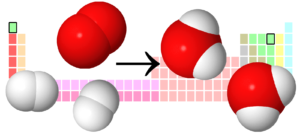
Sourc: Wikimedia Commons
In the example above one atom of oxygen and two atoms of hydrogen elements joined to form water which is a compounds
4 The basic structure of an atom includes a small and relatively massive nucleus, which contains protons and neutrons .
Outside the nucleus there are energy levels (also called shells), which contain one or more electrons. Energy levels are often called electron shells.
Neutrons have the highest mass and have no charge. Protons have a slightly smaller mass than neutrons and are positively charged. The electrons have almost no mass and are negatively charged. Electrons move around the nucleus in energy levels.
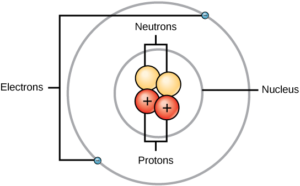
Source: Wikimedia Commons
3.Latin words from which the symbols of these metallic elements are derived are :-
Sodium, Na – Natrium.
Gold, Au : Aurum.
Lead, Pb: Plumbum.
Potassium , K : Kalium.
6 The compound formula provides information on the number of atoms of each element in a molecule. From the chemical formula of carbon dioxide, we can see that it contains a carbon atom and 2 oxygen atoms.
C1.2 Chemical Equations AQA GCSE Chemistry C1 Atomic Structure Kerboodle Answers Page no. 07
1a All symbol equations must be balanced according to the law of mass conservation. According to the law of mass conservation, in a chemical reaction, the mass of the products must be equal to the mass of the reagents. Therefore, the equations must be balanced with the same number of moles of reagents and products on both sides.
- H2+ Cl2→2HCl
- a. According to the law of conservation of mass, the total mass of the reactant should be equal to the mass of the products. If 33.6 g of MgCO3 decomposed, the mass of the reactant is 33.6 g. One of the products, MgO has a mass of 16 g. Hence, the mass of carbon dioxide produced is 33.6-16= 17.6 g.
b.MgCO3 (s) → MgO (s) + CO2 (g).
- a. 2KNO3→ 2KNO2+ O2
- 4Li + O2→ 2Li2O
- 4Fe + 3O2→ 2Fe2O3
- d. Fe2O3+ 3CO → 2Fe+ 3CO2
- Reaction of sodium metal, Na, with water H2O to form a solution of sodium hydroxide NaOH and hydrogen gas can be written as :-
2Na(s) + 2H2O(l) → 2NaOH(aq) + H2(g).
C1.3 Separating Mixtures AQA GCSE Chemistry C1 Atomic Structure Kerboodle Answers Page no. 09
- A mixture contains two or more substances that are not chemically combined. The individual components of a mixture retain their physical properties. Thus, the components of a mixture can be separated by simple physical means.
- ‘’ A mixture has no fixed composition, whereas a compound has’’. It means that A compound always has the same composition. A mixture can have different compositions.
A compound consists of the atoms of two or more elements that are chemically linked together. Since atoms always come together in the same proportion, the composition of a compound is always the same.
A mixture consists of two or more substances that are physically mixed in different proportions. It often retains many of the properties of its components, and the components can be separated from each other by physical means. For example, water is a compound that contains 2 hydrogen atoms and an oxygen atom chemically combined to form the H2O water molecule.
- Distillation can be used to remove dissolved impurities from a sample of water. When the water is purified by distillation, it is boiled in a container and the steam is sent to the cooling tubes. The steam is condensed and then collected as purified water in a second container. The impurities in the water remain in the first container and can be discarded.
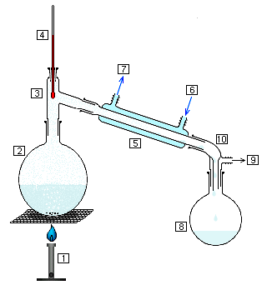
Source: Wikimedia Commons
- A mixture of sulphur powder and sodium nitrate can be separated by using Xylene and water. We will add water to the mixture of sulfur powder and sodium nitrate. Sulfur powder will be insoluble in water, while sodium nitrate will dissolve. Then we will filter this mixture. Sodium nitride and water will come out and the sulfur powder will adhere to the filter paper. The sulfur powder of the filter paper can be dried and extracted. The mixture of sodium nitrate and water will be distilled so that the water evaporates and the sodium nitrate is left behind.
C1.4 Fractional Distillation and Paper Chromatography AQA GCSE Chemistry C1 Atomic Strucutre Kerboodle Answers Page no. 11
1a. To separate a mixture of ethanol and water, we can use a process known as fractional distillation. This technique is based on the fact that the compounds in the mixture have different boiling points. We know that ethanol boils at a lower temperature than water, ethanol evaporates while most of the water remains a liquid. Then we can separate the ethanol and water mixture through this process. The boiling point of ethanol is 78 degrees and the water is 100 degrees. If the temperature is kept at about 80 degrees, all the ethanol will evaporate and collect. The water will remain in the flask.

Source: Wikimedia Commons
- This method of separation for ethanol and water is known as Fractional Distillation.
- It is easier to obtain a more concentrated sample of ethanol from the mixture of ethanol and water by fractional distillation that be simple distillation as ethanol and water have very close boiling points. The boiling point of ethanol is 78 degrees Celsius and water is 100 degrees celsius.
In distillation the solution forms steam before reaching the boiling point. In that case a fractionating column with glass beads is useful. Substances with a higher boiling point condense in colder glass beads and drip back into the flask. In this case, the water vapor will cool down in the glass beads and drip backwards. Substances with the lowest boiling point will continue to rise and pass to the condenser, cool and collected. In fractional distillation of ethanol, ethanol will raise first and collected and water will be left behind.
- a. Chromatography is a method of separating dyes in coloured ink. The ink is a mixture of different dyes and, therefore, we can separate these colors from each other by chromatography. When the ink is exposed to certain solvents, the colors dissolve and can be separated.
Components in the mixture are separated on the basis of solubility of
different components of the mixture in a suitable solvent.A capillary tube is used to spot the mixture on the chromatography paper. The paper is put inside a solvent and the solvent is allowed to run up the
chromatography paper. The component of the mixture which is more soluble in the solvent will
travel greater distance and will leave its mark near the top.
The component which is less soluble will have a mark near the bottom.
1.The greater the solubility of a substance in a solvent, the greater the distance traveled by a substance. In the chromatogram, substance B travels on paper higher than substance A, which means that substance B is more soluble in the solvent propanone of substance A.
-
Liquid Boling point in °C Water 100 Ethanol 78 propanol 97
When the boiling points of the two liquids in the mixture are close together, generally a difference of less than 40 degrees Celsius, fractional distillation is more efficient. The aforementioned liquids have a boiling point very close to each other, so it is not possible to separate them by simple distillation.
Fractional distillation completes several simple distillations in a single apparatus. In fractional distillation, the mixture is boiled in a fractionated column, a long tube that allows the liquid to evaporate and condense several times as it affects the colder air every time it moves towards the column. Crude oil is separated into its various components by fractional distillation.
C1.5 History of the Atom AQA GCSE Chemistry C1 Atom Strucutre Kerboodle Answers Page no. 13
- a. Dalton’s idea about the atom that scientisits no longer believe: –
C Atoms are solid spheres that cannot be split into simpler particles.
- Substances from the dalton’s list of elements which are not elements are :- Soda and Lime. Soda and Lime are made up of two more elements.
Lime is calcium Oxide and Soda is carbon dioxide in water.
- a. J.J Thomson discovered An electron at the end of 1800 s.
- J. J. Thomson, who discovered the electron in 1897, proposed the plum pudding model of the atom in 1904 before the discovery of the atomic nucleus to include the electron in the atomic model.
In the Thomson model, the atom is composed of electrons surrounded by a positively charged soup to balance the negative charges of the electrons, like the “prunes” negatively charged surrounded by a positively charged “pudding”.
The 1904 Thomson model was denied by the 1909 gold leaf experiment by Hans Geiger and Ernest Marsden.

Source: Wikimedia Commons
- The two ways in which Rutherford changed Thomson model of Atoms are :-
- Thomson said that atom is a sphere of positive charges and electrons are embedded as raisins in the pudding but Rutherford stated that the positive charge is concentrated at the centre which is the nucleus and majority of the space in an atom is empty.
- Thomson said that charge is distributed thoroughly in the atom but Rutherford stated that majority of the space in an atom is empty.
Rutherford tested Thomson’s hypothesis by inventing his “gold foil” experiment. Rutherford reasoned that if Thomson’s model was correct, then the mass of the atom extended throughout the atom. So if you shoot alpha particles at high speed (helium nuclei) at an atom, there would be very little to bypass alpha particles. He decided to try this with a thin film of gold atoms. As expected, most of the alpha particles passed through the gold leaf, but to his surprise some alpha particles bounced almost directly backwards.
Therefore, he suggested that the atom has a dense center of positive charge called the nucleus and the orbits of the electrons around the nucleus.
- Bohr has improved the Rutherford atomic model by proposing that electrons travel in circular orbits with specific energy levels. Bohr’s model was an improvement because he explained why the light emitted by atoms consists of lines of certain colors.
C1.6 Structure of the Atom AQA GCSE Chemistry C1 Atomic Strucutre Kerboodle Answers Pages : 15
- Protons and electrons have an electrical charge. This electrical charge is the same size for both, but protons are positive and electrons are negative.
Neutrons have no electrical charge; they are neutral.
These properties are summarised in the table showing the location, relative charge and relative mass of three subatomic particles
| Particle | Relative mass | Relative charge | Location |
| Proton | 1 | +1 | In the nucleus at the centre of the atom |
| Neutron | 1 | 0 | In the nucleus at the centre of the atom |
| Electron | 1/2000
-= 0.0005 |
-1 | Revolves around the nucleus in the shells |
- The element with 27 protons and 32 neutrons is Cobalt. Its symbol is Co, atomic number is 27 and mass number is 59.
- Atom is neutral Because the number of electrons and protons is always the same. Protons are positively charged (+), electrons are negatively charged (-). When its number is equal to the number of + and – it is also the same. And an equal number of – and +, of course, would give 0,0 represents a neutral charge. The total charge of the atom is neutral.
- Nitrogen atom with atomic number 7 and mass number 14 has Protons = 7, electrons = 7 and neutrons = 7.
- A chlorine atom with atomic number 17 and mass number 35 has Protons = 17, electrons = 17 and neutrons = 18.
- A silver atom, with atomic number 47 and mass number 108 has Protons = 47, electrons = 47 and neutrons = 61.
- A Uranium atom with atomic number 92 and mass number 235 has Protons = 92, electrons = 92 and neutrons = 143.
C1.7 Ions, Atoms and Isotopes AQA GCSE Chemistry C1 Atomic Structure Kerboodle Answers Page : 17
1 a) Protons: 5 , Neutrons: 6 , Electrons: 5
- b) Protons: 7 , Neutrons: 7 , Electrons: 7
- c) Protons: 12 , Neutrons: 12 , Electrons 12
- d) Protons: 17 , Neutrons: 20 , Electrons 17
- e) Protons: 53 , Neutrons: 74 , Electrons 53
- f) Protons: 9 , Neutrons: 10 , Electrons 10
- g) Protons: 15 , Neutrons: 16 , Electrons 18
- h) Protons: 19 , Neutrons: 20 , Electrons 18
- i) Protons: 13 , Neutrons: 14 , Electrons 10
- a. Isotopes are atoms with the same number of protons, but different numbers of neutrons. In other words, they have different atomic masses but the same atomic number. Isotopes are different forms of a single element.
- The isotope is C- 12 in Figure 1 as it has 6 electrons and 6 protons so its mass number is 12.
- Boron atom radium in nm will be : 0.09 nm. We will divide the radium by 10-9
- 1/10000 of 9 ×10-11m = 9 ×10-12mm.
- a. The samples of different isotopes of an element have different physical properties. Since they have different mass so the property like density that depends on mass will be different. For example, they have different densities due to their different masses and may or may not be radioactive.
- Isotopes have the same chemical properties because their reactions depend on their electronic structures. Because their atoms will have the same number of protons and, therefore, the electrons at their highest energy level. The electronic structure will be the same for all the isotopes of an element. Hence, they will show similar chemical properties.
C1.8 Electronic Structures AQA GCSE Chemistry C1 Atomic Strucutre Kerboodle Answers Pages: 19
- a. Innermost shell or first shell represents the lowest energy level in an atom.
- The lowest energy level (I shell) can hold upto 2 electrons and the second lowest energy level (II shell ) can hold up to 8 electrons .
- Arrangement of electrons in the atoms :-
He 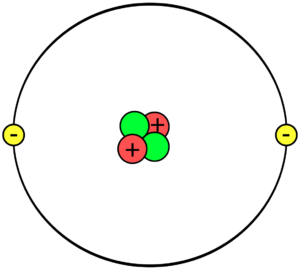 Be
Be
- Cl
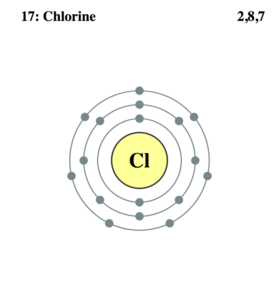
- Ar
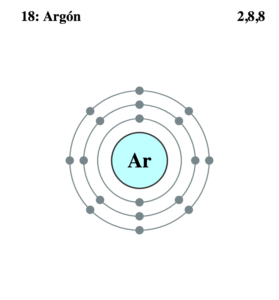
3. a. The electronic structure of potassium is 2,8,8,
b. A potassium atom has 1 electron in its highest energy level
4. The element in Figure 3 is phosphorus and the symbol is P
5.a. All elements of group 1 react in a similar way with oxygen as they all have one electron in their outermost layer. Since they have the same amount of electrons in their outermost layer, they react in a similar way. All group one elements reacts with oxygen to form metal oxides which forms alkali when dissolved in water.
b.Word equations for the reactions of lithium, sodium and potassium with oxygen:-
For lithium:
4Li(s)+O2 (g)→2Li2O(s)
For sodium:
4Na(s)+O2 (g)→2Na2O(s)
For potassium:
4K(s)+O2(g)→ 2K2O(s)
- Alkali metals burst into flames when heated and added to chlorine. They form metal chlorides.
Alkali metals + chlorine → alkali metal chloride
The word and chemical equations for the reaction between lithium and chlorine are:
Lithium + chlorine → lithium chloride
2Li (s) + Cl2 (g) → 2LiCl (s)
Word and chemical equations for the reaction that produces sodium chloride are:
Sodium + chlorine → sodium chloride
2Na (s) + Cl2 (g) → 2NaCl (s)
Summary Questions AQA GCSE Chemistry C1 Atomic Structure Kerboodle Answers Page: 20
- a. (i) The subatomic particles found in the nucleus of the atom are :- Protons and neutrons
(ii). The maximum number of electrons that each of the first two energy level or shells occupy
b (i) The overall charge on a atom is zero. Atom is neutral because an atom has Same number of protons (+) and electrons (–). So charges cancel out.
(ii) Atom can become an ion with a +2 charge by Losing two electrons. Loosing two electrons will leave the atoms with two more positive charges than negative charges so overall charge will be 2+.
(iii) The atomic number (also called the proton number) is the number of protons in an atom.
The mass number (also called the nucleon number) is the total number of protons and neutrons in an atom.
- a.A mixture is two or more substances not chemically bonded which can be separated by physical means.
- The difference between mixture and compound are summarized in the table below:-
Mixture |
Compound | |
| Composition | Variable composition – you can vary the amount of each substance in a mixture. | Definite composition – you cannot vary the amount of each element in a compound. |
| Joined or not | The different substances are not chemically joined together. | The different elements are chemically joined together. |
| Properties | Each substance in the mixture keeps its own properties. | The compound has properties different from the elements it contains. |
| Separation | Each substance is easily separated from the mixture. | It can only be separated into its elements using chemical reactions. |
| Examples | Air, sea water, most rocks. | Water, carbon dioxide, magnesium oxide, sodium chloride |
- (i) Hydrated copper (II) sulphate from its aqueous solution can be separated by Crystallisation, as the crystals are soluble in water. So evaporating water will crystallize the copper sulphate crystals.
(ii) A precipitate of lead iodide from the solution of lead nitrate and sodium iodide can be separated by filtration, as they precipitate is insoluble in the solution so can be collected in the filter paper and dried.
(iii) Water from the solution of potassium chloride can be separated by (simple) distillation, as water has a lower boiling point of 100 degrees so can be evaporated and passed through the condenser and collected.
(iv) Ethanol from the mixture of water and ethanol can be collected by fractional distillation as the boiling points are too close so ethanol will be evaporated first and collected. Water will be boiled at lower temperature, hit the glass beads and come back to the flask.
- a. The physical state of each element in the table at 25 degrees with be :-
Gas: fluorine, xenon;
liquid: bromine;
solid: caesium, strontium.
- Caesium will exists as liquid over the widest range of temperature as it has a greater difference between its melting and boiling point.
- The chemical symbol for atoms of each element in the table are:-
Bromine = Br; caesium = Cs; fluorine = F; strontium = Sr; xenon = Xe.
- Classification of each element in the table are :-
Non-metals: bromine, fluorine, xenon;
metals: caesium, strontium
- Electron structure of
(i) Fluorine Atom
2, 7
- Fluoride Ion F-
2, 8
- a. Neon is a non-metal as it is found to the right side of the periodic table. It has complete outer shell. Its electronic configuration is 2,8. It is a noble gas.
- They are more Metals in the periodic table. Metals are found on the left side of the periodic table.
iii. Neon has at atomic number of 10 so Neon atoms contain 10 protons.
- The mass number of the neon is 20 and the proton number is 10 so it will contain 20-10 =10 neutrons.
- Name of the group to which Neon belongs is Noble Gas which is Group 18.
- Xenon and Krypton are the two elements in the same group as Neon.
vii. Electron structure of the Neon atom is 2,8
viii. The special property of the electronic structure of Neon and the other elements in its group is that they have complete outer shells of electrons.
b.I. 88 Protons are present in the nucleus of each radium atom.
iI. Since radium belongs to group 2, radium atom has 2 electrons in its outermost shell. Group 2.
iii. Radium belongs to group 2 which is on the left side of the periodic table so radium is a metal.
- The difference in the atomic structure of radium-224, radium-226 and radium-228 is that Radium-228 has two more neutrons than radium-226, which has two more neutrons than radium-224.
- Electronic structure of calcium is 2, 8, 8, 2.
- Protons, neutron and electrons in calcium 2+ ions are :-
20 p, 20 n, 18 e.
- a. 2Na + Cl2→ 2NaCl
- 4Al + 3O2→ 2Al2O3
- 2Fe2O3+ 3C → 4Fe + 3CO2
- 2Al(OH)3→ Al2O3+ 3H2O
- 2Ba(NO3)2→ 2BaO + 4NO2+ O2
- 2C4H10+ 13O2 → 8CO2 + 10H2O.
Practice Questions AQA GCSE Chemistry C1 Atomic Structure Kerboodle Answers Page No. 21
- The improvement to Step 2 to get a better separation to separate rock salt is to Heat the mixture so that salt can get completely dissolved in water to form a solution.
01.2. Since the salt solution in figure 1 is the run off after filtration so the word that best describes it is a Filtrate.
01.3. Sand becomes the residue in Figure 1 as sand is insoluble in water. The sand particles being insoluble in water and greater in size than the holes of the filter paper are trapped in the filter paper and are separated from the runoff solution.
01.4. From the solution in Step 3 the student can get dry salt crystals by evaporation the solution. The water will evaporate crystallizing the salt crystals. The salt crystals can then be dried and collected.
01.5. Since Mixtures have no fixed composition the student could not have predicted the mass of dry salt crystals obtained.
02.1. In figure 2 the pencil line is completely immersed in the solvent. This will result in the complete dissolution of the ink in the solvent without any separation. In an actual chromatography set up the solvent should run up and dissolve the ink components as the solvent travel up.
02.2. The line in chromatography paper should be drawn with the pencil as pencil does not dissolve in the solvent so it will not interfere with the results.
02.3. In Figure 3, the green ink has separated into blue and yellow spot so we can conclude that the green ink is a mixture of blue and yellow spot.
02.4. Yellow dye move further up the paper as The yellow dye is more soluble in the solvent than the blue dye so it has travelled the greater distance.
03.1. In Result 1 very few alpha particles repelled backwards so it shows that: atoms have nuclei at the centre with dense positive charge at the centre. Rest of the space is empty so the alpha particles passed straight through and the deflection was at the centre only.
In Result 2 most of the alpha particles went straight through the gold foil so it shows that: most of an atom is empty space or hollow.
103.2. The Similarities between the isotopes of chlorine are :-
Both isotopes have the same number of protons, electrons and atomic number. Their proton number, electron number and atomic number is 17..
Differences between the isotopes have chlorine are :-
Cl35 has 18 neutrons and Cl 37 has 20 neutrons. Chlorine 35 has the mass number of 35 and chlorine 37 has the mass number of 37.
03.3. Isotopes of chlorine has similar chemical properties as both isotopes have the same number of electrons and electronic configuration and Chemical properties depend on the electron configuration.
03.4 The relative atomic mass is a (weighted) average. Since the atomic mass average is closer to 35 than 37 so it means there must be more of chlorine–35 than 37.
Banner 10DISCLAIMER
Disclaimer: I have tried by level best to provide the answers and video explanations to the best of my knowledge. All the answers and notes are written by me and if there is any similarity in the content then it is purely coincidental. But this is not an alternative to the textbook. You should cover the specification or the textbook thoroughly. This is the quick revision to help you cover the gist of everything. In case you spot any errors then do let us know and we will rectify it. References: BBC Bitesize AQA GCSE Science Kerboodle textbook Wikipedia Wikimedia Commons Join Our Free Facebook Group : Get A* in GCSE and A LEVEL Science and Maths by Mahima Laroyia: https://www.facebook.com/groups/expertguidance.co.uk/ For Free Tips, advice and Maths and Science Help
